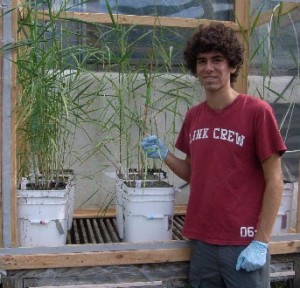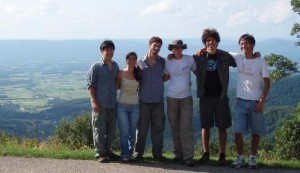Q&A with David Gonzalez, 2009 Summer Intern
Major: Evolution, Ecology and Biodiversity
School: University of California-Davis, Class of 2011

Intern David Gonzalez poses with some of his Phragmites australis plants
What drew you to the Smithsonian Environmental Research Center?
The big-picture research that the scientists do here interested me, particularly the experiments relating to global climate change. Among other things, scientists of my generation are going to have to understand how climate change will impact organisms. We talk about it a lot in my classes, so it was cool to have the opportunity to have hands-on experience exploring some of these issues as an undergrad.
You were here for ten weeks. What was your research project about?
I worked on a global change project that examined the relationship between microbes in the soil and Common Reed, or Phragmites australis. Through a process called methanogenesis, the microbes produce methane, a powerful greenhouse gas, which the plants help to emit into the atmosphere. Because Phragmites australis is found in wetlands worldwide, it’s important to look at how its methanogenesis rates might be affected by global change. Basically we wanted to see if rising CO2 and nitrogen levels exacerbate the problem of methane emissions. So I spent the summer growing Phragmites australis under conditions of elevated CO2 and nitrogen and then measured the response of the microbes and plants.
Do you feel like you spent your summer being an active scientist?
Half of the summer I felt like a scientist; the other half I felt like a gardener. There were a lot of day-to-day chores like watering the plants, counting them, giving them fertilizer, and weeding them. I had to make sure these plants grew to the best of their ability in the short time we had to grow them.
So you learned about the challenges and realities of doing science?
A lot of things I learned this summer relate to how many little things go into doing scientific research – from going out and buying fuses for a machine when it broke down, to purchasing nail polish at a drug store so we could take a peel from a leaf to count stomatal density.
What exactly did you do with nail polish?
We used it in some pilot studies. You apply nail polish to the leaf, let it dry, put scotch tape on it, and then pull it off. This creates a kind of caste of the leaf that you can put on a microscope slide so you can examine a leaf’s cellular structure. For instance, we can go through and count the guard cells, which lets us figure stomatal density and helps us understand how the leaf is responding to the treatments we applied.
You were in the biogeochemistry lab. Did you interact much with the other labs at SERC?
Yeah, one of the great things about SERC is that you’re surrounded by scientists with all these different areas of expertise. I got a lot of help from the forest ecology lab; they let me use some of their instruments for measuring leaf area. But we also got to go on lab exchanges. I spent a day on the water with the “Crab Lab;” I helped them catch and tag blue crabs. And then I also spent a number of evenings setting up mouse traps in the forest with a friend who was interning in the Terrestrial Ecology Lab. In general, we were encouraged to find out what the other labs were up to, which I often did just by talking with the other interns.
What are the dorms like?
The Green Village is awesome. It has a kitchen, a common area and feels like a nice cozy dorm.
How much independence did you have?
Usually you put in eight hours of work a day; occasionally you work more. After that though, you’re free. We cooked dinners together in the evenings. Some of the interns had a garden with a behemoth of a basil plant – that made for a great pesto party. And then we spent weekends exploring the East Coast. I saw fireworks in Washington, DC, on the Fourth of July; camped in Shenandoah National Park; and swam in the Atlantic Ocean.

SERC's summer interns on a day-trip to the Shenandoah Valley
Was it difficult to get around?
A lot of the interns had cars. That was something I was worried about in the beginning, but everybody turned out to be really friendly. If you needed groceries, there were always people going to the grocery store. If you wanted to visit Washington, DC, it was easy to round up people to hit the Smithsonian Museums. The weekend excursions were great.
You’ll graduate in 2011. How do you want to use the knowledge you’ve gained here at SERC?
I’m definitely planning on doing more scientific research – maybe related to climate change, maybe not. Something that I’m very interested in is communicating the importance of environmental science to the general public and to policy makers. I want to be able to convey why it’s important to think about things like climate change, where your food comes from, farming practices, carbon emissions and things like that. That’s sort of my long-term interest – which I hope will go hand-in-hand with my future studies and research experiences.


wow… You use Nail Polish with different way, it’s cool, I do not really understand biology, but i hopefully your research work well.